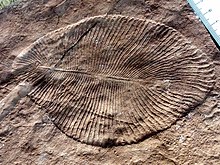Our website is made possible by displaying online advertisements to our visitors.
Please consider supporting us by disabling your ad blocker.
Cambrian explosion





The Cambrian explosion is when many animal phyla first appeared in the fossil record. It happened 541 million years ago (mya).[1][2][3] Probably most had evolved before then, but that was their first appearance as fossils.[4]
Before about 580 mya it seems that most organisms were simple. They were made of individual cells, occasionally organized into colonies. Over the following 70 or 80 million years the rate of evolution seemed to accelerate.[5] By the end of the Cambrian most phyla we know today existed.
The Cambrian explosion has caused much scientific debate. The seemingly rapid appearance of fossils in the 'primordial strata' was noted as early as the mid 19th century,[6] and Charles Darwin saw it as one of the main objections that could be made against his theory of evolution by natural selection.[7]
- ↑ The Cambrian period
- ↑ "The Cambrian explosion – timing". Archived from the original on 2018-03-07. Retrieved 2011-03-26.
- ↑ Butterfield N.J. (2001). "Ecology and evolution of Cambrian plankton". The ecology of the Cambrian radiation (PDF). Columbia University Press, New York. pp. 200–216. ISBN 9780231106139. Retrieved 2007-08-19.
- ↑ Bambach, Richard K.; Bush, Andrew M.; Erwin, Douglas H. (2007). "Autecology and the filling of ecospace: key metazoan radiations". Palæontology. 50 (1): 1–22. doi:10.1111/j.1475-4983.2006.00611.x. S2CID 84142740.
- ↑ Butterfield N.J. 2007. Macroevolution and macroecology through deep time. Palaeontology 50 (1): 41. doi:10.1111/j.1475-4983.2006.00613.x.
- ↑ Buckland, W. (1841). Geology and mineralogy considered with reference to natural theology. Lea & Blanchard. ISBN 1147868948.
- ↑ Darwin (1859). On the origin of species by natural selection. Murray, London, United Kingdom. pp. 315–31. ISBN 1602061440. OCLC 176630493.
Previous Page Next Page


